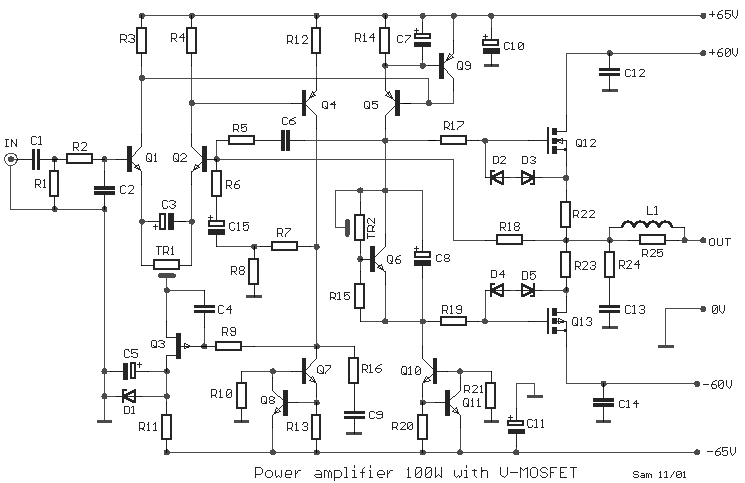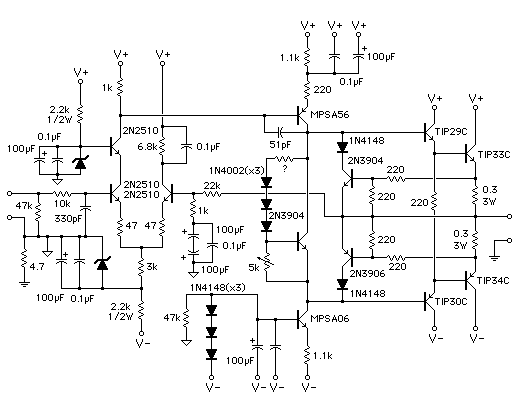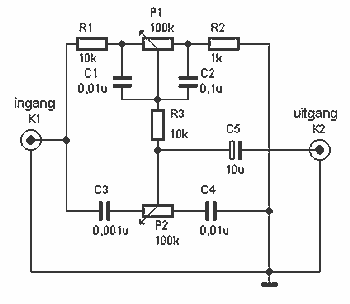
Three-Level Audio Power Indicator

This circuit is designed to indicate the power output level of any audio amplifier. It is simple, portable, and displays three power levels that can be set to any desired value. For a standard HiFi stereo power amplifier, such as the 25W model described, the suggested power output values are provided for easy setup, although other settings are also feasible. IC1A serves as the input buffer, which feeds three voltage comparators and LED drivers through a variable DC voltage generated by R5 and the smoothing action of C4. To ensure setting stability, the supply voltage for IC1 and the trimmers R6 and R7 is reduced and clamped to 5.1V. To utilize this circuit, connect the generator to the amplifier input and the Audio Power Indicator to the amplifier’s output in parallel with the oscilloscope probe or the audio millivoltmeter input. For example, set the output of the 1kHz sine wave generator to read 14V on the audio millivoltmeter (equivalent to 24.5W at 8 Ohms). Adjust R2 until LED D3 illuminates, ensuring that D3 turns off when the generator's output is slightly diminished.
The audio power output indicator circuit provides an effective means of monitoring the power levels of audio amplifiers. The circuit's design incorporates an input buffer (IC1A) that ensures a stable signal is fed into the subsequent voltage comparators. These comparators are calibrated to trigger at specific voltage thresholds corresponding to the desired power output levels, which are indicated by the illumination of LEDs.
The variable DC voltage generated by resistor R5 and capacitor C4 plays a crucial role in smoothing the input signal, allowing for accurate voltage comparison. This smoothing action helps to mitigate fluctuations in the input signal that could lead to erroneous readings. The clamping of the supply voltage to 5.1V ensures that the operational amplifiers and the trimmers operate within a stable voltage range, enhancing the reliability of the circuit.
In practical application, the circuit is connected to an audio amplifier output. The use of an oscilloscope or audio millivoltmeter allows for precise measurement of the output voltage, facilitating the adjustment of the circuit settings. The adjustment of trimmer R2 is particularly important, as it sets the threshold for LED D3, which visually indicates when the amplifier reaches the specified output power level.
Overall, this circuit is an invaluable tool for audio engineers and enthusiasts, allowing for real-time monitoring of amplifier performance and ensuring optimal operation within desired parameters. Its portability and simplicity make it suitable for various applications, from home audio setups to professional sound reinforcement systems.This circuit is intended to indicate the power output level of any audio amplifier. It is simple, portable, and displays three power levels that can be set to any desired value. For a standard HiFi stereo power amplifier like the 25W one described in these pages, the power output values suggested are as followings: The above values were chosen for easy setup, but other settings are possible. IC1A is the input buffer, feeding 3 voltage comparators and LEDs drivers by means of a variable dc voltage obtained by R5 and C4 smoothing action. In order to achieve setting stability, the supply of IC1 and trimmers R6 & R7 is reduced and clamped to 5.
1V * Connect the generator to the amplifier input and the Audio Power Indicator to the output of the amplifier, in parallel with the oscilloscope probe or the audio millivoltmeter input. * Example: set the output of the 1KHz sinewave generator to read 14V on the audio millivoltmeter (24.
5W 8 Ohms). Set R2 until D3 illuminates, and be sure that D3 turns-off when diminishing a little the generator`s output. 🔗 External reference
The audio power output indicator circuit provides an effective means of monitoring the power levels of audio amplifiers. The circuit's design incorporates an input buffer (IC1A) that ensures a stable signal is fed into the subsequent voltage comparators. These comparators are calibrated to trigger at specific voltage thresholds corresponding to the desired power output levels, which are indicated by the illumination of LEDs.
The variable DC voltage generated by resistor R5 and capacitor C4 plays a crucial role in smoothing the input signal, allowing for accurate voltage comparison. This smoothing action helps to mitigate fluctuations in the input signal that could lead to erroneous readings. The clamping of the supply voltage to 5.1V ensures that the operational amplifiers and the trimmers operate within a stable voltage range, enhancing the reliability of the circuit.
In practical application, the circuit is connected to an audio amplifier output. The use of an oscilloscope or audio millivoltmeter allows for precise measurement of the output voltage, facilitating the adjustment of the circuit settings. The adjustment of trimmer R2 is particularly important, as it sets the threshold for LED D3, which visually indicates when the amplifier reaches the specified output power level.
Overall, this circuit is an invaluable tool for audio engineers and enthusiasts, allowing for real-time monitoring of amplifier performance and ensuring optimal operation within desired parameters. Its portability and simplicity make it suitable for various applications, from home audio setups to professional sound reinforcement systems.This circuit is intended to indicate the power output level of any audio amplifier. It is simple, portable, and displays three power levels that can be set to any desired value. For a standard HiFi stereo power amplifier like the 25W one described in these pages, the power output values suggested are as followings: The above values were chosen for easy setup, but other settings are possible. IC1A is the input buffer, feeding 3 voltage comparators and LEDs drivers by means of a variable dc voltage obtained by R5 and C4 smoothing action. In order to achieve setting stability, the supply of IC1 and trimmers R6 & R7 is reduced and clamped to 5.
1V * Connect the generator to the amplifier input and the Audio Power Indicator to the output of the amplifier, in parallel with the oscilloscope probe or the audio millivoltmeter input. * Example: set the output of the 1KHz sinewave generator to read 14V on the audio millivoltmeter (24.
5W 8 Ohms). Set R2 until D3 illuminates, and be sure that D3 turns-off when diminishing a little the generator`s output. 🔗 External reference





